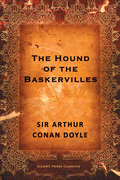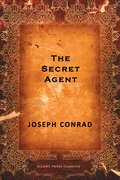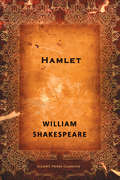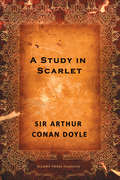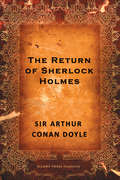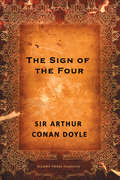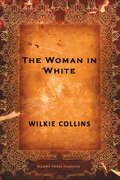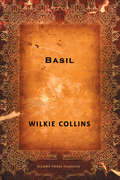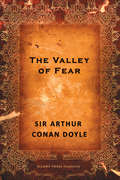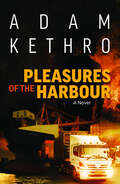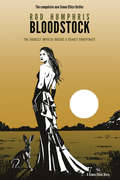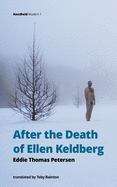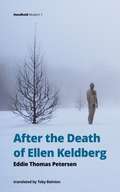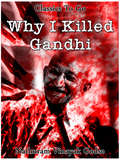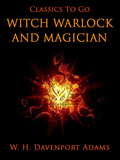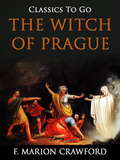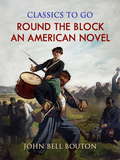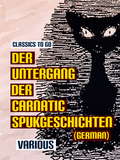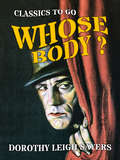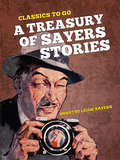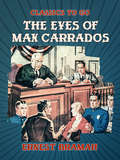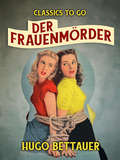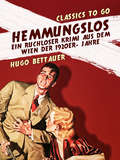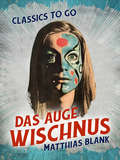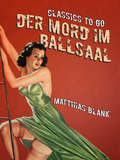- Table View
- List View
The Hound of the Baskervilles: Another Adventure of Sherlock Holmes
by Sir Arthur Conan DoyleThe Hound of the Baskervilles is the third of the crime novels written by Sir Arthur Conan Doyle featuring the detective Sherlock Holmes. It is set largely on Dartmoor in Devon in England's West Country and tells the story of an attempted murder inspired by the legend of a fearsome, diabolical hound of supernatural origin. Sherlock Holmes and his companion Dr. Watson investigate the case. This was the first appearance of Holmes since his apparent death in "The Final Problem", and the success of The Hound of the Baskervilles led to the character's eventual revival.
The Secret Agent
by Joseph ConradThe Secret Agent: A Simple Tale is a novel by Joseph Conrad, published in 1907. The story is set in London in 1886 and deals with Mr Adolf Verloc and his work as a spy for an unnamed country (presumably Russia). The Secret Agent is one of Conrad's later political novels in which he moved away from his former tales of seafaring. The novel deals broadly with anarchism, espionage and terrorism. It also deals with exploitation of the vulnerable in Verloc's relationship with his brother-in-law Stevie, who has a learning difficulty. Because of its terrorism theme, it was noted as "one of the three works of literature most cited in the American media" two weeks after the September 11 attacks.
Hamlet: A Tragedy
by William ShakespeareHamlet is Shakespeare's most popular, and most puzzling, play. It follows the form of a "revenge tragedy," in which the hero, Hamlet, seeks vengeance against his father's murderer, his uncle Claudius, now the king of Denmark. Much of its fascination, however, lies in its uncertainties. Among them: What is the Ghost--Hamlet's father demanding justice, a tempting demon, an angelic messenger? Does Hamlet go mad, or merely pretend to? Once he is sure that Claudius is a murderer, why does he not act? Was his mother, Gertrude, unfaithful to her husband or complicit in his murder?
A Study in Scarlet (Sherlock Holmes Book #1)
by Sir Arthur Conan DoyleUnlikely yet complementary flatmates, detective Sherlock Holmes and Dr. John Watson collaborate to solve the murder of a young man whose corpse is found in an abandoned house. Through deductive reasoning and scientific inquiry, the pair reveal the roots of the man's murder extend to the Salt Lake Valley in Utah—thousands of miles away from the streets of London.The first of four novels and five short-story collections, Arthur Conan Doyle's A Study in Scarlet debuted one of the most famous detective pairings in literary history.
The Return of Sherlock Holmes (Sherlock Holmes Short Story Collection #3)
by Arthur Conan DoyleAfter a three-year absence, the presumed-dead Sherlock Holmes returns, incognito, to London. Now discovered in a local shop by his friend and former partner, Dr. John Watson, Holmes resumes his detective business just in time to avert an assassination attempt and secure his safe return to public life. Coming after what Holmes fans refer to as "The Great Hiatus," The Return of Sherlock Holmes contains thirteen short stories including "The Adventure of the Empty House," in which Holmes explains his return from the dead, as well as three of what Arthur Conan Doyle considered to be his best stories: "The Adventure of the Dancing Men," "The Adventure of the Priory School," and "The Adventure of the Second Stain."
The Sign of the Four (Sherlock Holmes Book #2)
by Sir Arthur Conan DoyleA new client, Mary Morstan, engages Sherlock Holmes' services to solve two mysteries: the disappearance of her father, Captain Arthur Morstan, and her receipt of one perfect pearl in the mail each year since answering a newspaper advertisement. But when Holmes' investigation reveals a priceless treasure, the stakes are raised and murder becomes the focus of his inquiry. The second novel to feature Sherlock Holmes and Dr. John Watson, The Sign of the Four introduces Mary Marston, Watson's future wife.
The Woman in White
by Wilkie CollinsThe Woman in White is Wilkie Collins' fifth published novel, written in 1859. It is considered to be among the first mystery novels and is widely regarded as one of the first (and finest) in the genre of "sensation novels". The story is sometimes considered an early example of detective fiction with protagonist Walter Hartright employing many of the sleuthing techniques of later private detectives. The use of multiple narrators (including nearly all the principal characters) draws on Collins's legal training, and as he points out in his Preamble: "the story here presented will be told by more than one pen, as the story of an offence against the laws is told in Court by more than one witness". When Walter Hartright comes to the aid of a mysterious woman in white, he finds himself unable to forget this chance encounter. And when he joins the Limmeridge household as a tutor to the Fairlie family, his curiosity about the woman is ever-heightened when he discovers the family's connection to her. But all is not what it seems to be at Limmeridge House, and Walter, now deeply in love with Mr. Fairlie's niece, the beautiful Laura, must unravel one of the greatest betrayals possible in order to save his beloved.
Basil
by Wilkie CollinsWhen Basil enters into a secret marriage with a young woman with whom he has fallen in love at first sight, he agrees to live apart for one year, seeing his young wife only in the company of a chaperone, and pining for the day when they may be together. But when Basil discovers his spouse in the arms of another, his reaction has tragic and lasting consequences.
The Valley of Fear (Sherlock Holmes Book #4)
by Sir Arthur Conan DoyleSherlock Holmes and Dr. John Watson must unravel a complicated case of murder and mistaken identity after Holmes receives a warning from an agent in Professor Moriarty's employ that John Douglas, a man unknown to Holmes, is in danger. But when they are called to assist with the murder investigation of Mr. Douglas, Holmes and Watson must decipher the significance of events from twenty years in the past before they can uncover Moriarty's link to Mr. Douglas and his death.
Pleasures of the Harbour: A Novel
by Adam KethroAdam Askew, a young man in a hurry, always wanted to be financially independent. Armed with guts, determination and a cocky self-assurance, he sets up a shipping company with a view to take on the world, one ton of cargo at a time.Fed up with the cliquey set-up in Durban, he takes a gutsy gamble, the biggest risk of his life, one that will ultimately make or break him. He heads for the big city lights of swanky 80s Joburg and is soon wining and dining at the Top of the Carlton, sipping the best champagne in London and making some enemies along the way.Set in the closing decades of the 20th century in sanction-wracked South Africa, Pleasures of the Harbour navigates a world of dodgy business partners, dubious deals and a few failed attempts at love before Adam can finally, and honestly, say he’s made it.Part adventure, part action, and lots of wheeling and dealing means readers are in for a rollicking ride in this highly entertaining novel that traverses the high seas and low roads of Southern Africa, while opening boardroom and a few bedroom doors along the way.Adam Kethro, the author, saw his school years fly by in Welkom, Brakpan and Durban. After two attempts at matric, a short dip as a stoker on the Railways, and a stint in the army's horse division, he began his career in the shipping industry.
Bloodstock (Simon Ellice #3)
by Rod HumphrisAfter what feels like a lifetime of mayhem, Simon Ellice returns to the Hampshire village where he grew up. He enjoys the solace and tranquility of rural life, working on a farm and getting to know the lively locals, but suddenly Si walks right into a deadly mystery. Old friends are going missing and then turning up dead. Someone from the City is spreading their evil tentacles and Si dives into London's underworld to uncover a conspiracy of poisoning, murder and pagan ritual that threatens those closest to him. Written with Humphris' razor-sharp style, this is Simon Ellice's darkest and most challenging adventure yet, touching on themes of sacrifice and objectification, that threaten the very foundations of our civilised world.
After the Death of Ellen Keldberg (PDF)
by Eddie Thomas Petersen Toby BaintonThe Danish seaside town of Skagen is an artists’ paradise in summer, but only the locals live there in winter. The middle-aged artist Ellen Keldberg was found frozen on a street bench, and now lies laid out on her bed, waiting for a post-mortem. Two visitors come from Copenhagen on a snowy night after her death. Her student nephew Mikkel is there to organise her funeral, yet he can barely remember Aunt Ellen and knows nothing about her life. Anne Sofie comes to pursue her ruthless quest single-mindedly. She will allow no-one to hide, or obscure the truth about Ellen, and leads Mikkel into a hopeless chase. Before Anne Sofie has finished, there will be blood in the snow, and she will have photographed death. This subtle novel by the Danish writer Eddie Thomas Petersen is a family saga, and a portrait of Skagen in the dark and in the snow, full of art, alliances and old secrets. Toby Bainton’s translation does full justice to the gripping narration.
After the Death of Ellen Keldberg (Handheld Modern #1)
by Eddie Thomas Petersen Toby BaintonThe Danish seaside town of Skagen is an artists’ paradise in summer, but only the locals live there in winter. The middle-aged artist Ellen Keldberg was found frozen on a street bench, and now lies laid out on her bed, waiting for a post-mortem. Two visitors come from Copenhagen on a snowy night after her death. Her student nephew Mikkel is there to organise her funeral, yet he can barely remember Aunt Ellen and knows nothing about her life. Anne Sofie comes to pursue her ruthless quest single-mindedly. She will allow no-one to hide, or obscure the truth about Ellen, and leads Mikkel into a hopeless chase. Before Anne Sofie has finished, there will be blood in the snow, and she will have photographed death. This subtle novel by the Danish writer Eddie Thomas Petersen is a family saga, and a portrait of Skagen in the dark and in the snow, full of art, alliances and old secrets. Toby Bainton’s translation does full justice to the gripping narration.
Why I killed Gandhi (Classics To Go)
by Nathuram GodseGodse approached Gandhi on January 30, 1948 during the evening prayer at 5:15PM. When Godse bowed, one of the girls flanking and supporting Gandhi, said to Godse, "Brother, Bapu is already late" and tried to put him off, but he pushed her aside and shot Gandhi in the chest three times at point-blank range with a semi-automatic pistol. Gandhi was taken to Birla-House, where he later died. This is the autobiography of Gandhi's killer. (Excerpt from Wikipedia)
Witch, Warlock, and Magician: Historical Sketches Of Magic And Witchcraft In England And Scotland (Classics To Go)
by W. H. Davenport AdamsIt was not the author's purpose in this volume to attempt a general history of magic and alchemy, or a scientific inquiry into their psychological aspects. He confined himself to a sketch of their progress in England and to a narrative of the lives of our principal magicians. It is also devoted to a historical review of witchcraft in Great Britain, and an examination into the most remarkable witch trials. (Excerpt from Goodreads)
The Witch of Prague: A Fantastic Tale (Classics To Go)
by F. Marion CrawfordExcerpt: "A great multitude of people filled the church, crowded together in the old black pews, standing closely thronged in the nave and aisles, pressing shoulder to shoulder even in the two chapels on the right and left of the apse, a vast gathering of pale men and women whose eyes were sad and in whose faces was written the history of their nation. The mighty shafts and pilasters of the Gothic edifice rose like the stems of giant trees in a primeval forest from a dusky undergrowth, spreading out and uniting their stony branches far above in the upper gloom. From the clerestory windows of the nave an uncertain light descended halfway to the depths and seemed to float upon the darkness below as oil upon the water of a well. Over the western entrance the huge fantastic organ bristled with blackened pipes and dusty gilded ornaments of colossal size, like some enormous kingly crown long forgotten in the lumber room of the universe, tarnished and overlaid with the dust of ages. Eastwards, before the rail which separated the high altar from the people, wax torches, so thick that a man might not span one of them with both his hands, were set up at irregular intervals, some taller, some shorter, burning with steady, golden flames, each one surrounded with heavy funeral wreaths, and each having a tablet below it, whereon were set forth in the Bohemian idiom, the names, titles, and qualities of him or her in whose memory it was lighted. Innumerable lamps and tapers before the side altars and under the strange canopied shrines at the bases of the pillars, struggled ineffectually with the gloom, shedding but a few sickly yellow rays upon the pallid faces of the persons nearest to their light."
Round the Block: An American Novel (Classics To Go)
by John Bell BoutonIn Round the Block (1864), John Bell Bouton, stirs together comedy and pathos to explore the schemes and dreams of the average and extraordinary people inhabiting and intermingling on a single New York City block. In the path of the novel's circumambulation lie mystery, romance, and a murder trial, as love-matches and fortunes are made and lost through invention, speculation, and flimflam - plenty of flimflam. This richly-charactered novel, told with Dickensian brio, offers a fascinating slice of life, vivid in detail, of the bustling big-city habits and mores of America shortly before the Civil War. (Introduction by Grant Hurlock)
Der Untergang der Carnatic Spukgeschichten (Classics To Go)
by VariousSpukgeschichten von Gebrüder Grimm, Wilhelm Hauff, Friedrich Gerstäcker, Paul Heyse, A. J. Mordtmann, Heinrich Zschokkke
Whose Body? (Classics To Go)
by Dorothy SayersThe stark naked body was lying in the tub. Not unusual for a proper bath, but highly irregular for murder -- especially with a pair of gold pince-nez deliberately perched before the sightless eyes. What's more, the face appeared to have been shaved after death. The police assumed that the victim was a prominent financier, but Lord Peter Wimsey, who dabbled in mystery detection as a hobby, knew better. In this, his first murder case, Lord Peter untangles the ghastly mystery of the corpse in the bath. (Goodreads)
A Treasury of Sayers Stories (Classics To Go)
by Dorothy SayersA good collection of short stories. If you enjoy Agatha Christie, you should enjoy Dorothy Sayers. Dated as they are, once the readers get past the cultural references and old-fashioned language, one finds exquisitely crafted stories. Dorothy Sayers is the perfect writer both for those who read for the puzzle of a mystery and those who read for the sake of the setting and the characters. She balances both with a rare sensitivity. (Goodreads)
The Eyes of Max Carrados (Classics To Go)
by Ernest BramahMax Carrados is one of the most unusual detectives in all fiction. He is blind – and yet he has developed his other faculties to such an amazing degree that they more than compensate for his lack of sight.‘Lose one sense and the others, touch, taste, smell, hearing improve…with a little dedicated training.’ Carrados can read a newspaper headline with the touch of his fingers, detect a man wearing a false moustache because ‘he carries a five yard aura of spirit gum’ and shoot a villain by aiming at the sound of his beating heart. Assisted by his sharp-eyed manservant, Parker, Carrados is the mystery-solver par excellence. Here is a collection of the best of Max Carrados, a set of stories featuring a series of baffling puzzles to challenge the greatest of detectives. They are written by Ernest Bramah with great wit, style and panache. This is vintage crime fiction at its best. (Goodreads)
Der Frauenmörder (Classics To Go)
by Hugo BettauerIn diesem Roman der 20er Jahre stürmen Hauswartsfrauen in höchster Erregung die Polizeireviere, denn es verschwinden heiratstolle Mädels zuhauf. Ein blonder Herr mit Kneifer hat sie alle abgeholt - ein Serienmörder? Die Berliner Bevölkerung steht im Gerichtssaal Kopf - ein verkannter Poet soll der Mörder sein. (Wikipedia)
Hemmungslos Ein ruchloser Krimi aus dem Wien der 1920er- Jahre (Classics To Go)
by Hugo BettauerIn seinem Kriminalroman Hemmungslos, einem Sittenbild der ersten Jahre der Zwischenkriegszeit, gelingt es Hugo Bettauer in grellen Bildern und gnadenlos überzeichneten Klischees die massiven, gesellschaftlichen Umwälzungen nach Ende des Ersten Weltkriegs darzustellen: Seine Welt der 1920er Jahre ist schwer gezeichnet vom Aufeinandertreffen unterschiedlicher Gesellschaftsentwürfe, von feministischem Aufbegehren versus erzkonservativer Rollenbilder und einem zutiefst wienerischen Antisemitismus. (Wikipedia)
Das Auge Wischnus (Classics To Go)
by Matthias BlankWalter Eller, ein gestandener Indien-Veteran hat bei seinen Kämpfen gegen die Aufständischen das Auge einer heiligen Statue als "Belohnung" mitgehen lassen. Es ist das "Auge Wischnus". Jahre später wird Eller, der inzwischen ein wohlhabender Mann geworden ist, ermordet. Schnell sprechen alle von der Rache Wischnus und seiner Jünger. (Amazon)
Der Mord im Ballsaal (Classics To Go)
by Matthias BlankExcerpt: "Das Weib, auf dem sein lauernder Blick ruhte, ging am Arme ihres Tänzers langsam um den Saal, sich zu verschnaufen, und fächelte sich lächelnd Kühlung zu. Sie trug ein Kleid aus blaßgelber Seide, das Hals und Nacken offen ließ und so einen Körper verriet, der von berückender Schönheit sein mußte. Die zarte, blaugeäderte Haut war von blendend blassem Schimmer, wie die Narzissen Blüten, die auf ihrem jugendlichen Busen schwankend lagen."
